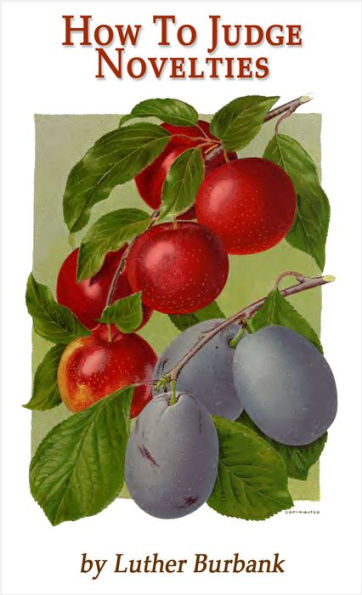How to Judge Novelties
All about developing new varieties
Luther Burbank was probably America's most famous botanist, horticulturist and pioneer in agricultural science. He developed more than 800 strains and varieties of plants over his lifetime. Burbank's varied creations included fruits, flowers, grains, grasses, and vegetables. He developed a spineless cactus (useful for cattle-feed) and the plumcot, and over a hundred more.
This 1911 booklet describes several of his earlier plant creations, like the Burbank Cherry, The Patagonia Strawberry, The 'Standard' Prune, the GLOW plum, and many others.
Burbank's most successful strains and varieties include the Shasta daisy, the fire poppy (note possible confusion with the California wildflower, Papaver californicum, which is also called a fire poppy), the "July Elberta" peach, the "Santa Rosa" plum, the "Flaming Gold" nectarine, the "Wickson" plum (named after agronomist Edward J. Wickson), the freestone peach, and the white blackberry.
Student's of Burbank and his methods would be wise to also examine the other books he wrote and co-wrote, on his methods and results, including his eight-volume How Plants Are Trained to Work for Man (1921), and Twentieth Century Fruits (also available for the Nook).
"1137253575"
Luther Burbank was probably America's most famous botanist, horticulturist and pioneer in agricultural science. He developed more than 800 strains and varieties of plants over his lifetime. Burbank's varied creations included fruits, flowers, grains, grasses, and vegetables. He developed a spineless cactus (useful for cattle-feed) and the plumcot, and over a hundred more.
This 1911 booklet describes several of his earlier plant creations, like the Burbank Cherry, The Patagonia Strawberry, The 'Standard' Prune, the GLOW plum, and many others.
Burbank's most successful strains and varieties include the Shasta daisy, the fire poppy (note possible confusion with the California wildflower, Papaver californicum, which is also called a fire poppy), the "July Elberta" peach, the "Santa Rosa" plum, the "Flaming Gold" nectarine, the "Wickson" plum (named after agronomist Edward J. Wickson), the freestone peach, and the white blackberry.
Student's of Burbank and his methods would be wise to also examine the other books he wrote and co-wrote, on his methods and results, including his eight-volume How Plants Are Trained to Work for Man (1921), and Twentieth Century Fruits (also available for the Nook).
How to Judge Novelties
All about developing new varieties
Luther Burbank was probably America's most famous botanist, horticulturist and pioneer in agricultural science. He developed more than 800 strains and varieties of plants over his lifetime. Burbank's varied creations included fruits, flowers, grains, grasses, and vegetables. He developed a spineless cactus (useful for cattle-feed) and the plumcot, and over a hundred more.
This 1911 booklet describes several of his earlier plant creations, like the Burbank Cherry, The Patagonia Strawberry, The 'Standard' Prune, the GLOW plum, and many others.
Burbank's most successful strains and varieties include the Shasta daisy, the fire poppy (note possible confusion with the California wildflower, Papaver californicum, which is also called a fire poppy), the "July Elberta" peach, the "Santa Rosa" plum, the "Flaming Gold" nectarine, the "Wickson" plum (named after agronomist Edward J. Wickson), the freestone peach, and the white blackberry.
Student's of Burbank and his methods would be wise to also examine the other books he wrote and co-wrote, on his methods and results, including his eight-volume How Plants Are Trained to Work for Man (1921), and Twentieth Century Fruits (also available for the Nook).
Luther Burbank was probably America's most famous botanist, horticulturist and pioneer in agricultural science. He developed more than 800 strains and varieties of plants over his lifetime. Burbank's varied creations included fruits, flowers, grains, grasses, and vegetables. He developed a spineless cactus (useful for cattle-feed) and the plumcot, and over a hundred more.
This 1911 booklet describes several of his earlier plant creations, like the Burbank Cherry, The Patagonia Strawberry, The 'Standard' Prune, the GLOW plum, and many others.
Burbank's most successful strains and varieties include the Shasta daisy, the fire poppy (note possible confusion with the California wildflower, Papaver californicum, which is also called a fire poppy), the "July Elberta" peach, the "Santa Rosa" plum, the "Flaming Gold" nectarine, the "Wickson" plum (named after agronomist Edward J. Wickson), the freestone peach, and the white blackberry.
Student's of Burbank and his methods would be wise to also examine the other books he wrote and co-wrote, on his methods and results, including his eight-volume How Plants Are Trained to Work for Man (1921), and Twentieth Century Fruits (also available for the Nook).
1.0
In Stock
5
1

How to Judge Novelties

How to Judge Novelties
eBook
$1.00
Related collections and offers
1.0
In Stock

Product Details
| BN ID: | 2940162898054 |
|---|---|
| Publisher: | Loose Cannon Ent. |
| Publication date: | 06/28/2020 |
| Sold by: | Barnes & Noble |
| Format: | eBook |
| File size: | 2 MB |
From the B&N Reads Blog
